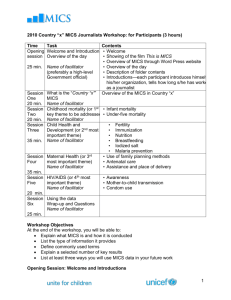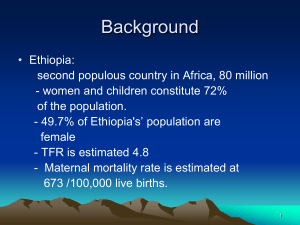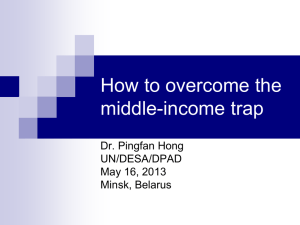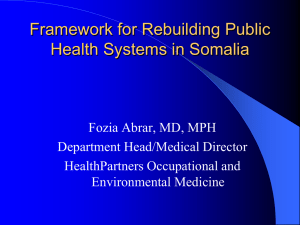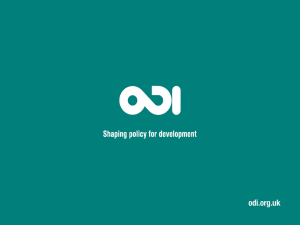Nigeria Journalists Workshop
advertisement
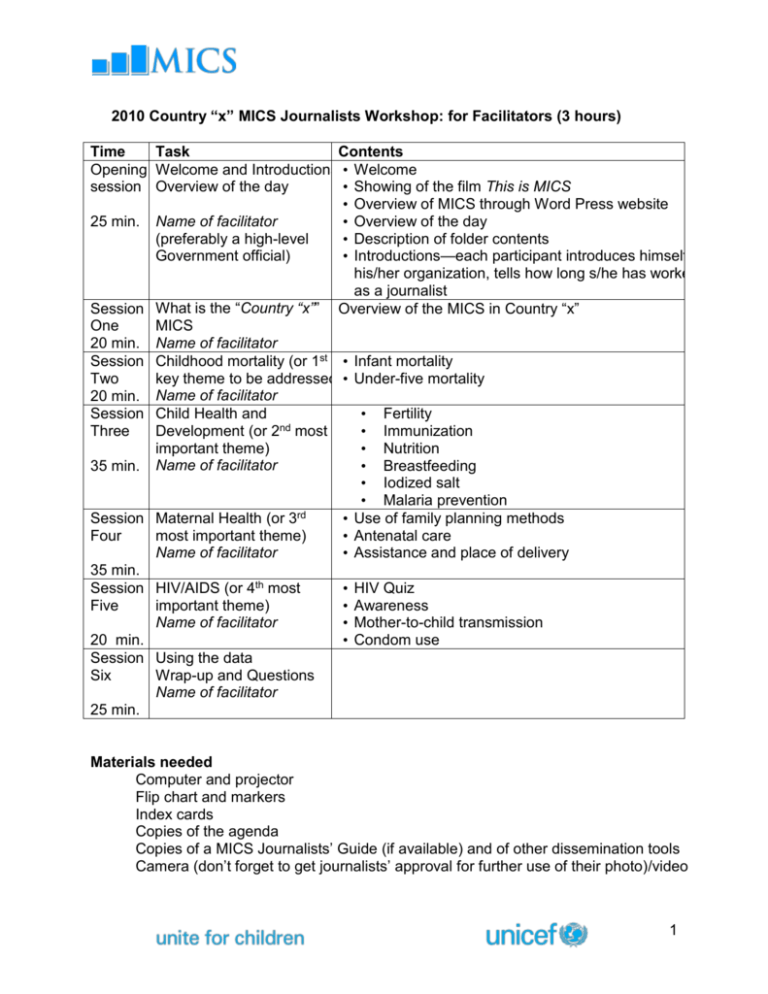
2010 Country “x” MICS Journalists Workshop: for Facilitators (3 hours)
Time
Task
Contents
Opening Welcome and Introductions • Welcome
• Showing of the film This is MICS
session Overview of the day
• Overview of MICS through Word Press website
25 min. Name of facilitator
• Overview of the day
(preferably a high-level
• Description of folder contents
Government official)
• Introductions—each participant introduces himself,
his/her organization, tells how long s/he has worked
as a journalist
Session What is the “Country “x”” Overview of the MICS in Country “x”
One
MICS
20 min. Name of facilitator
Session Childhood mortality (or 1st • Infant mortality
Two
key theme to be addressed) • Under-five mortality
20 min. Name of facilitator
Session Child Health and
• Fertility
Three
Development (or 2nd most
• Immunization
important theme)
• Nutrition
35 min. Name of facilitator
• Breastfeeding
• Iodized salt
• Malaria prevention
rd
Session Maternal Health (or 3
• Use of family planning methods
Four
most important theme)
• Antenatal care
Name of facilitator
• Assistance and place of delivery
35 min.
Session HIV/AIDS (or 4th most
• HIV Quiz
Five
important theme)
• Awareness
Name of facilitator
• Mother-to-child transmission
20 min.
• Condom use
Session Using the data
Six
Wrap-up and Questions
Name of facilitator
25 min.
Materials needed
Computer and projector
Flip chart and markers
Index cards
Copies of the agenda
Copies of a MICS Journalists’ Guide (if available) and of other dissemination tools
Camera (don’t forget to get journalists’ approval for further use of their photo)/video
1
Workshop Objectives
At the end of the workshop, participants will be able to:
Explain what MICS is and how it is conducted
List the type of information it provides
Define commonly used terms
Explain a selected number of key results
List at least three ways journalists will use MICS data in their future work
Opening Session: Welcome and Introductions
Up to 25 minutes
Presentation of facilitators from the MICS implementing agency, government institutions,
women’s groups, National AIDS Commission, UNICEF, as well as from other UN agencies
and NGOs who may be attending as specialists/resource persons to answer questions
during the workshop.
Each participant introduces himself, his/her organization, tells how long s/he has worked as
a journalist and describes level of knowledge about the MICS in the country.
Talking points
Welcome everyone
Thank participants for coming
Introduce facilitators
Explain the objectives of the workshop
Stress that the workshop is designed to be interactive. We will not be lecturing
Remind journalists of the importance of accurate reporting
Go through handouts
o Agenda
o Journalists’ Guide and/or Guide to MICS if available
Ask each participant to introduce him/herself and tell group about their work
Ask for any questions and concerns
2
Session One: What is the Country “x” MICS?
20 minutes
Learning Objectives
By the end of the session, participants will be able to:
Briefly explain the 2010 Country “x” MICS and its purpose
List the main topics the survey covers
Explain what a nationally representative sample is
Key message
The MICS is a valuable tool for journalists as well as public health specialists; it provides
key information on such issues as: childhood mortality, child health and development,
maternal health, child protection and HIV/AIDS. The findings are readily accessible, free,
and used worldwide and datasets can be used free of charge for further analysis.
Talking Points
The 2010 Country “x” MICS is a very detailed household survey that collects information
about childhood mortality, maternal and child health, nutritional practices, child protection,
HIV/AIDS and much more.
In Country “x”, “number of” households from all parts of the country were surveyed
between February and May 2010.
“Number of” women (aged 15 to 49) were interviewed.
“Number of” men (aged 15 to 59) were interviewed.
Information was collected on “number of” children under age 5.
Four questionnaires were used: a Household Questionnaire, a Women’s
Questionnaire, a Questionnaire for Children Under Age 5 and a Men’s
Questionnaire.
The survey was conducted by the “Name of the Implementing Agency” with technical
assistance from UNICEF. Most of the funds for the local costs were provided by
“name of the funding agencies” through “name of the institution”.
Funds were also provided by “names of other agencies/institutions”.
MICS data are available in print and on the Internet. They are free and available to
everyone.
What topics are covered in a MICS? What is a nationally representative sample?
Discussion/exercise with journalists to list all topics they think are covered in the survey.
Brainstorming of ideas on what constitutes a nationally representative sample.
Ask participants to come up with list and write down on flip chart. Do this for several
minutes so participants can see how much MICS covers.
MICS surveys cover a range of topics including
education
orphanhood and vulnerability of children
use of insecticide-treated mosquito nets
maternal and child health
3
nutrition
reproductive health
sexual behavior and knowledge of HIV/AIDS/sexually transmitted infections (STIs)
malaria
child disciplinary practices
early child development
Details: discuss further only if asked by participants
It is worth mentioning the following:
How are the data collected?
The data were collected by “number of” mobile interviewing teams each consisting of
one supervisor, one field editor, four to five female interviewers, one measurer and
one male interviewer.
The interviewers receive comprehensive training on the ethics of interviewing and on
the technical content of the surveys. They also conducted several practice
interviews.
Interviews were conducted in “names of local languages”.
Staff were trained to measure level of iodine in the salt and to take height and weight
(anthropometric) measurements of both mothers and children.
4
Session Two: Childhood Mortality
20 minutes
Learning Objectives
By the end of the session, participants will be able to:
Define in simple terms what childhood mortality is and how it is calculated.
Explain differences between infant and under-five mortality rates.
Put into context the level of mortality among children in the country.
Compare, if possible, the level of mortality in the country to that observed in other
countries in the region and in the rest of the world.
Explain how mortality has changed over time (over the last 10 or 20 years).
Describe the most plausible causes of mortality among children.
Key Message
(Actual proportion) of children do not live to see their fifth birthday.
Under-5 mortality has slightly increased since last MICS in the country.
Mortality levels in Country “x” are generally higher than those observed in
neighboring countries.
Talking Points
MICS uses a reliable method to estimate childhood mortality levels by asking a few
simple questions about the number of live births a woman has ever had and the
number of those children who have died.
Infant and under-5 mortality rates are basic indicators of a country’s socioeconomic
situation and quality of life.
Reducing under-5 mortality is one of the overarching goals of the Millennium
Development Goals (MDG4).
For every 1,000 babies born, (actual number) die before their first birthday (infant
mortality).
For every 1,000 children born, more than (100, 200, 250???) will die by their fifth
birthday.
Discuss possible reasons why Country “x” has higher childhood mortality levels than
most of its neighbors.
Identify possible reasons for upward/downward under-5 mortality trends.
Present some key maternal and child health interventions the Government may
introduce to improve child survival.
5
Session Three: Child Health and Development
35 minutes
Learning Objectives
By the end of session, participants will be able to:
Define the total fertility rate and that it stands at (actual number) children per woman.
Know that child nutrition and health are still serious problems in Country “x”.
Understand that there has been no improvement in overall children’s health status
since 19?? or 20??
Show that the percentage of children receiving all vaccines has decreased from
(actual percentage) in 19?? to only (actual percentage) in 2010.
Understand the health benefits of breastfeeding, particularly of exclusive
breastfeeding.
Identify the key interventions families can use to prevent malaria or treat diarrhea.
Key Message
There is a strong relationship between the education level of the mother and the health
status of her children. More educated and more economically advantaged women: 1) have
smaller families and 2) are more likely to seek good medical care for themselves and their
babies. Children whose mothers have no education are less likely to be fully immunized
and more likely to be malnourished and more likely to die in infancy and childhood.
In order to be fully immunized, children should receive the whole series of recommended
vaccines at the proper age. Children should be exclusively breastfed until they reach 6
months as mother’s milk is the best nutrient infants can get, especially when they receive
the first milk (within one hour of birth), or colostrum, which protects babies from infections
before their immune system is mature. Exclusive breastfeeding is on the rise. Use of
insecticide-treated bednets for children under-5 is a simple intervention that can
dramatically lower malaria. Use of oral rehydration salts (ORS) is a simple recommended
way to treat diarrhea. If ORS packets are not available, a homemade rehydration therapy
can be prepared with water, salt and sugar.
Talking Points
Fertility
Definition of the term “TFR”: what is the total fertility rate?
Women in Country “x” still have very large families. The number of children born per
woman is higher than in most other countries in the region. Women have on average
(actual number) children but they only want to have (actual number).
Over 1 in 3 (actual proportion) young women age 15-19 have already begun
childbearing.
6
The TFR differs greatly by residence: it is almost twice as high for rural women than
for urban women.
Immunization
Only (actual percentage) of children 12-23 months received all the recommended
vaccinations.
??% received no vaccinations at all.
Vaccination rates vary according to a number of factors. Rates are higher for:
o First births
o Children living in urban areas
o Children born to women who live in the (name of) region
o Children born to women who have attended secondary or higher education
Nutrition
There has been no improvement in child nutrition since 19??.
(Actual percentage) of kids under five are stunted, meaning that they are too short
for their age, a sign that they may have suffered from poor nutrition over an
extended period.
(Actual percentage) of children are wasted; in other words, they are too thin (or
weigh too little for their height) which is usually a sign of acute or recent nutritional
deficit, a factor of high-risk mortality.
(Actual percentage) are underweight, or they weigh too little for their age, which
could be caused by either stunting or wasting.
Breastfeeding
Exclusive breastfeeding is recommended for the first six months of life, since breast
milk contains all the nutrients that a baby needs.
Antibodies in breast milk provide immunity to disease.
Only about half (actual proportion) of babies are exclusively breastfed for the first six
months of life.
This is a dramatic increase from 20?? when only (actual percentage) of babies were
exclusively breastfed for the first six months of life.
Malaria prevention (in areas at risk of malaria and in malaria-endemic countries)
Children are especially at high risk of contracting malaria. Malaria is most often fatal in
young children. The major preventive method—use of insecticide-treated mosquito nets
(ITN)—is very low (actual percentage), but represents a dramatic recent increase thanks to
the government’s new program to distribute insecticide treated bednets in the most malaria
at-risk regions of the country.
Malaria is a major public health problem in Country “x”. The use of mosquito nets is
the primary intervention recommended to reduce malaria transmission.
It is estimated that (actual percentage) of hospital visits in Country “x” are related to
malaria.
Only 20% of children sleep under ITN mosquito nets.
7
Session Four: Maternal Health
35 minutes
Learning Objectives
By the end of the session, participants will be able to:
Identify the two most important family planning methods women use.
Define antenatal care and assistance at delivery and know that maternal health
services should continue to be improved.
Explain how pregnant women can be protected from malaria.
Key Message
Use of family planning is high compared to that of other countries in the region, but there is
still an unmet need for family planning.
More educated and more economically advantaged women are more likely to use
contraception, and to seek good medical care for themselves and their babies. Whereas
(actual percentage) of women receive some professional assistance during their
pregnancy, only (actual percentage) give birth with the assistance of a trained provider.
Pregnant women are most likely to get malaria. Malaria complicates pregnancy. It is
recommended, as a preventive measure, that pregnant women take at least 2 doses of
intermittent antimalarial treatment during pregnancy, such as SP/Fansidar, but MICS data
show that very few women follow the recommendation.
Talking Points
Family Planning
Despite the fact that almost all married women surveyed knew of at least one
contraceptive method, only (actual percentage) of them are actually using one;
(actual proportion) are using a modern method. This is higher than most countries
(in the region) where a MICS has been conducted.
Contraceptive use is:
o Slightly higher in urban than in rural areas.
o Higher in the (name of) region and lowest in (name of region).
o Higher in women with more education.
o (Actual percentage) in women with no formal education vs. (actual
percentage) in women with at least some secondary education.
o Lower in young or old women compared to those aged 25-44.
The most common method of contraception is injectables (??%), followed by female
sterilization (??%), and the pill (?%).
(Actual percentage) of women are not having their family planning needs met, that is
to say that they would either like to wait at least 2 years before having another child
or that they don’t want to have any more children, but they are not using a method of
family planning.
8
Antenatal Care
Antenatal care is the care a woman receives while she is pregnant. Many dangers
can be avoided if a woman goes to a health centre or to a skilled birth attendant
when she first suspects she is pregnant. She should then have at least four checkups throughout each pregnancy.
A skilled birth attendant (such as a doctor, nurse, midwife or auxiliary midwife) will
help ensure a safer pregnancy and healthy baby.
About (actual percentage) of women who gave birth in the past 2 years received
antenatal care from a skilled birth attendant at least once during their pregnancy.
Care during childbirth
A much lower proportion of women are receiving assistance by a trained provider
during childbirth (compared to those receiving antenatal care).
Still a high proportion of women deliver their baby at home, most of them without the
assistance of a trained provider, putting them and their babies at risk in the case of
an emergency.
(Actual percentage) of women who die in Country “x”, die due to maternity-related
causes (only for countries where maternal mortality module is used).
Maternal mortality (only for countries where maternal mortality module is used)
The maternal mortality ratio is estimated at (actual number) deaths per 100,000 live
births.
MICS uses the “sisterhood method”, which relies on questions posed to all adults in
a household about the survival of their sisters. This produces a maternal mortality
ratio estimate centered on 10 (??) to 12 (??) years before the survey.
Malaria prevention
Malaria is more dangerous during pregnancy, especially during the first pregnancy. It
can cause severe anaemia ('thin blood'), miscarriage, premature birth or stillbirth.
Babies born to mothers who have had malaria during pregnancy will probably be
underweight and therefore more vulnerable to infection or death during their first
year.
(Actual percentage) of women received at least 2 doses of intermittent antimalarial
treatment (SP/Fansidar) during pregnancy. Most of them were treated during routine
antenatal clinic visits.
Why are these maternal health issues so important?
Women who have good antenatal care have better birth outcomes. Antenatal care
equals healthier mothers and babies.
Births that take place in hospital and with trained attendants also lead to lower
morbidity and mortality among mothers and babies.
9
Session Five: HIV/AIDS
20 minutes
Learning Objectives
At the end of this session, participants will be able to:
Identify three important ways to avoid HIV infection.
Discuss differences in awareness and knowledge of HIV/AIDS and its prevention
among women.
Understand how HIV can be transmitted from mother to child.
List three ways they can use this data in their work.
Key Message
Awareness of HIV is high but knowledge is incomplete. More people need to be tested.
Overall, discriminatory attitudes and practices are still very common.
Quiz
Ask participants to estimate the HIV prevalence in Country “x”; identify individuals most at
risk in the society, and why; and the best ways men and women can protect themselves
from contracting HIV. In high-prevalence countries, talk about the social and economic
ramifications of high levels of HIV.
Talking Points
HIV/AIDS Awareness
Almost all women have heard of AIDS but a good proportion still has
misconceptions. Very few women have a good understanding about AIDS
transmission. (Actual proportion) of women do not believe a teacher with the AIDS
virus should be allowed to continue teaching and (actual proportion) would not buy
fresh vegetables from a vendor who has the AIDS virus.
Mother-to-child transmission
(Actual proportion) of women know that the AIDS virus can be transmitted during
pregnancy, at childbirth, or by breastfeeding.
Condom Use
Condom use is one of the most important ways to avoid HIV/AIDS, especially in
high-risk encounters. Only women who were sexually active in the year before the
survey were asked questions about condom use.
Overall, (actual proportion) of women reported using a condom the last time they
had sex.
Condom use is highest when women have sex with nonmarital, noncohabitating
partners.
Abstinence
Only (actual proportion) of women choose to abstain from sex as a way to protect
themselves from contracting HIV.
10
Session Six: Using the Data and Wrap-up
25 minutes
Learning Objectives
At the end of this session, participants will be able to:
List at least three ways to use MICS data
Describe how to bring MICS data to life for their audiences
Develop at least three stories that feature or use MICS data
Key Message
There are many ways to use MICS data; it can be used to support many of the stories you
report everyday on health, the economy, and politics.
Talking Points
You can report on the data itself—interesting findings and trends, for example, or
use the data to support other stories. You can compare regions of the country to
each other, compare urban vs. rural respondents or girls to boys.
Human interest stories are always popular. Remember that behind these numbers
are real children going, or who would like to go, to school; whose parents, or
themselves, live with HIV/AIDS; who get regularly sick with malaria, etc; and of real
women who may be pregnant and living so far from a health center that they rarely
receive antenatal care; of others who can not afford, or do not know about, family
planning methods; others who suffer from domestic violence, etc.
You can illustrate the issues, surprising findings, and trends revealed by the survey
with stories that feature individuals and families.
You can use survey data to educate your audience about malnutrition in rural areas,
nationwide school attendance, family planning, use of maternal and child health
services in a few targeted provinces, and HIV/AIDS prevention.
You can use MICS data to support many of the stories you report everyday on
health, the economy, and politics.
Often the data influence policymakers’ decisions to implement new policies or
develop new programs.
Oftentimes these decisions are controversial—yet newsworthy.
Story ideas may include:
The appointment of new people to health-related positions in government, the
private sector or NGOs.
The availability (or the lack) of new services, including child health services or
HIV/AIDS counseling and treatment.
The announcement of new policies concerning reproductive health, education, child
labor, etc.
The launch of a massive national-based bednet distribution.
A discussion on the health and education budget allocations over the last five years.
The beginning of a program to systematically register all births.
11
The decision to honor a former health minister who had launched a number of
projects that benefited the population (perfect scenario to assess the current
situation).
A discussion of new trends in family planning use, girls’ education, infant health, etc.
New ideas discussed in the society for improving the health status of a local area or
of the entire country.
A comparison of Country “x” with other countries in the region on many of the major
health indicators.
12
